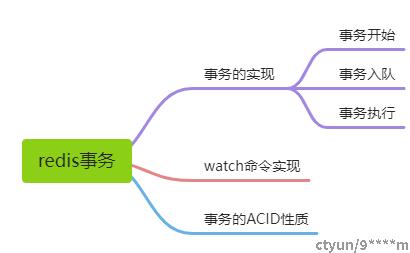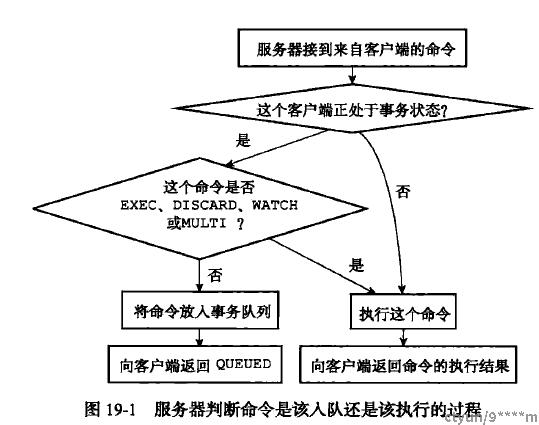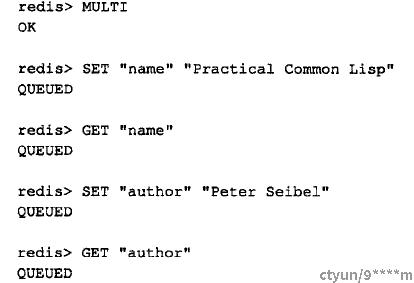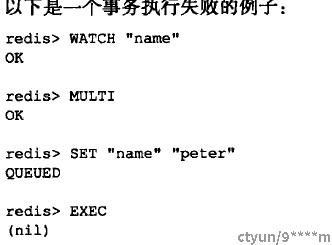
redis通过MULTI、EXEC、WATCH等命令实现事务功能。事务提供了一种将多个命令请求打包,然后一次性,按顺序地执行多个命令的机制,将事务中所有命令执行完毕,才会去执行其他客户端的请求。
事务以MULTI开始,以EXEC提交执行:

事务的实现
一个事务从开始到结束会经历三个阶段,事务开始,事务入队,事务执行
事务开始
MULTI命令标识事务的开始,表示进入事务状态
void multiCommand(client *c) {
if (c->flags & CLIENT_MULTI) {
addReplyError(c,"MULTI calls can not be nested");
return;
}
c->flags |= CLIENT_MULTI; // 添加事务标识
addReply(c,shared.ok);
}事务入队
处于事务状态时,执行命令,该命令会入队,简单来说就是保存到一个队列中,缓存起来,就是缓存在服务器中的该client的数据结构中
struct client {
multiState mstate; /* MULTI/EXEC state */
};
typedef struct multiState {
// 事务队列,FIFO顺序,记录所有的命令
multiCmd *commands; /* Array of MULTI commands */
int count; /* Total number of MULTI commands */
int cmd_flags; /* The accumulated command flags OR-ed together.
So if at least a command has a given flag, it
will be set in this field. */
int cmd_inv_flags; /* Same as cmd_flags, OR-ing the ~flags. so that it
is possible to know if all the commands have a
certain flag. */
} multiState;
/* Client MULTI/EXEC state */
typedef struct multiCmd {
robj **argv; // 参数
int argc; // 参数个数
struct redisCommand *cmd; // 命令指针
} multiCmd;
int processCommand(client *c) {
...
/* Exec the command */
if (c->flags & CLIENT_MULTI && // 处于事务状态
c->cmd->proc != execCommand && c->cmd->proc != discardCommand &&
c->cmd->proc != multiCommand && c->cmd->proc != watchCommand &&
c->cmd->proc != resetCommand)
{
queueMultiCommand(c); // 加入队列
addReply(c,shared.queued);
} else {
call(c,CMD_CALL_FULL);
c->woff = server.master_repl_offset;
if (listLength(server.ready_keys))
handleClientsBlockedOnKeys();
}
return C_OK;
}
/* Add a new command into the MULTI commands queue */
void queueMultiCommand(client *c) {
multiCmd *mc;
int j;
/* No sense to waste memory if the transaction is already aborted.
* this is useful in case client sends these in a pipeline, or doesn't
* bother to read previous responses and didn't notice the multi was already
* aborted. */
if (c->flags & CLIENT_DIRTY_EXEC)
return;
c->mstate.commands = zrealloc(c->mstate.commands,
sizeof(multiCmd)*(c->mstate.count+1));
mc = c->mstate.commands+c->mstate.count;
mc->cmd = c->cmd;
mc->argc = c->argc;
mc->argv = zmalloc(sizeof(robj*)*c->argc);
memcpy(mc->argv,c->argv,sizeof(robj*)*c->argc);
for (j = 0; j < c->argc; j++)
incrRefCount(mc->argv[j]);
c->mstate.count++;
c->mstate.cmd_flags |= c->cmd->flags;
c->mstate.cmd_inv_flags |= ~c->cmd->flags;
}
举例,如果执行下面命令:

入队后的数据结构示意图如下:

事务执行
当执行EXEC命令时,server会遍历命令队列,依次执行,并将结果全部返回
void execCommand(client *c) {
int j;
robj **orig_argv;
int orig_argc;
struct redisCommand *orig_cmd;
int was_master = server.masterhost == NULL;
if (!(c->flags & CLIENT_MULTI)) {
addReplyError(c,"EXEC without MULTI");
return;
}
// 如果有到期失效的key,则不会执行事务
/* EXEC with expired watched key is disallowed*/
if (isWatchedKeyExpired(c)) {
c->flags |= (CLIENT_DIRTY_CAS);
}
/* Check if we need to abort the EXEC because:
* 1) Some WATCHed key was touched.
* 2) There was a previous error while queueing commands.
* A failed EXEC in the first case returns a multi bulk nil object
* (technically it is not an error but a special behavior), while
* in the second an EXECABORT error is returned. */
// 判断两个标识决定是否能执行事务
// CLIENT_DIRTY_EXEC标识是当watched key被修改时会被设置
if (c->flags & (CLIENT_DIRTY_CAS|CLIENT_DIRTY_EXEC)) {
addReply(c, c->flags & CLIENT_DIRTY_EXEC ? shared.execaborterr :
shared.nullarray[c->resp]);
discardTransaction(c);
return;
}
uint64_t old_flags = c->flags;
/* we do not want to allow blocking commands inside multi */
c->flags |= CLIENT_DENY_BLOCKING;
// 事务执行完毕时,设置不WATCH所有key,watch key -> client列表的哈希表,
// 如果client列表中有该client则删除该client,表示不监听该key
// 每个事务执行完毕后,该client不会watch任何key,恢复到初始状态
/* Exec all the queued commands */
unwatchAllKeys(c); /* Unwatch ASAP otherwise we'll waste CPU cycles */
server.in_exec = 1;
orig_argv = c->argv;
orig_argc = c->argc;
orig_cmd = c->cmd;
addReplyArrayLen(c,c->mstate.count);
// 依次执行命令
for (j = 0; j < c->mstate.count; j++) {
c->argc = c->mstate.commands[j].argc;
c->argv = c->mstate.commands[j].argv;
c->cmd = c->mstate.commands[j].cmd;
/* ACL permissions are also checked at the time of execution in case
* they were changed after the commands were queued. */
int acl_errpos;
int acl_retval = ACLCheckAllPerm(c,&acl_errpos);
if (acl_retval != ACL_OK) {
char *reason;
switch (acl_retval) {
case ACL_DENIED_CMD:
reason = "no permission to execute the command or subcommand";
break;
case ACL_DENIED_KEY:
reason = "no permission to touch the specified keys";
break;
case ACL_DENIED_CHANNEL:
reason = "no permission to access one of the channels used "
"as arguments";
break;
default:
reason = "no permission";
break;
}
addACLLogEntry(c,acl_retval,acl_errpos,NULL);
addReplyErrorFormat(c,
"-NOPERM ACLs rules changed between the moment the "
"transaction was accumulated and the EXEC call. "
"This command is no longer allowed for the "
"following reason: %s", reason);
} else {
call(c,server.loading ? CMD_CALL_NONE : CMD_CALL_FULL);
serverAssert((c->flags & CLIENT_BLOCKED) == 0);
}
/* Commands may alter argc/argv, restore mstate. */
c->mstate.commands[j].argc = c->argc;
c->mstate.commands[j].argv = c->argv;
c->mstate.commands[j].cmd = c->cmd;
}
// restore old DENY_BLOCKING value
if (!(old_flags & CLIENT_DENY_BLOCKING))
c->flags &= ~CLIENT_DENY_BLOCKING;
c->argv = orig_argv;
c->argc = orig_argc;
c->cmd = orig_cmd;
discardTransaction(c);
/* Make sure the EXEC command will be propagated as well if MULTI
* was already propagated. */
if (server.propagate_in_transaction) {
int is_master = server.masterhost == NULL;
server.dirty++;
/* If inside the MULTI/EXEC block this instance was suddenly
* switched from master to slave (using the SLAVEOF command), the
* initial MULTI was propagated into the replication backlog, but the
* rest was not. We need to make sure to at least terminate the
* backlog with the final EXEC. */
if (server.repl_backlog && was_master && !is_master) {
char *execcmd = "*1\r\n$4\r\nEXEC\r\n";
feedReplicationBacklog(execcmd,strlen(execcmd));
}
afterPropagateExec();
}
server.in_exec = 0;
}WATCH命令的实现
通过watch命令监控key,如果发现key被修改了,则拒绝执行事务


每个数据库都保存着dict *watched_keys字典,该字典的key是数据库的健,value是一个链表,保存着监控该key的客户端

所有对数据库的修改操作,如set,sadd等命令,最后会调用到touchWatchedKey检查是否有客户端在对该key进行监听,如果有,则将客户端的CLIENT_DIRTY_CAS标识打开,标识事务安全性已被破坏,在execCommand函数中,会检查该标识,标识打开了则执行事务不会执行。
/* "Touch" a key, so that if this key is being WATCHed by some client the
* next EXEC will fail. */
void touchWatchedKey(redisDb *db, robj *key) {
list *clients;
listIter li;
listNode *ln;
if (dictSize(db->watched_keys) == 0) return;
clients = dictFetchValue(db->watched_keys, key);
if (!clients) return;
/* Mark all the clients watching this key as CLIENT_DIRTY_CAS */
/* Check if we are already watching for this key */
listRewind(clients,&li);
while((ln = listNext(&li))) {
client *c = listNodeValue(ln);
c->flags |= CLIENT_DIRTY_CAS;
}
}事务的ACID性质
事务总是具有原子性、一致性和隔离性,并且当Redis 运行在某种特定的持久化模式下时,事务也具有耐久性。
原子性
要么就执行事务中的所有操作,要么就一个操作也不执行。
Redis的事务和传统的关系型数据库事务的最大区别在于,Redis不支持事务回滚机制,即使事务队列中的某个命令在执行期间出现了错误,整个事务也会继续执行下去,直到将事务队列中的所有命令都执行完毕为止。
一致性
- 入队错误:如果一个事务在入队命令的过程中,出现了命令不存在,或者命令的格式不正确等情况,那么Redis将拒绝执行这个事务。
- 执行错误:即使在事务的执行过程中发生了错误,服务器也不会中断事务的执行,它会继续执行事务中余下的其他命令,并且已执行的命令(包括执行命令所产生的结果)不会被出错的命令影响。
- 服务器停机:如果服务器运行在无持久化的内存模式下,那么重启之后的数据库将是空白的;如果服务器运行在RDB 模式下,服务器可以根据现有的RDB 文件来恢复数据;如果服务器运行在AOF模式下,根据现有的AOF文件来恢复数据。
隔离性
因为Redis使用单线程的方式来执行事务,所以Redis的事务总是以串行的方式运行的,并且事务也总是具有隔离性的。
耐久性
事务的耐久性指,当一个事务执行完毕时,执行这个事务所得的结果已经被保存到永久性存储介质里面了,即使服务器在事务执行完毕之后停机,执行事务所得的结果也不会丢失。
重点回顾
